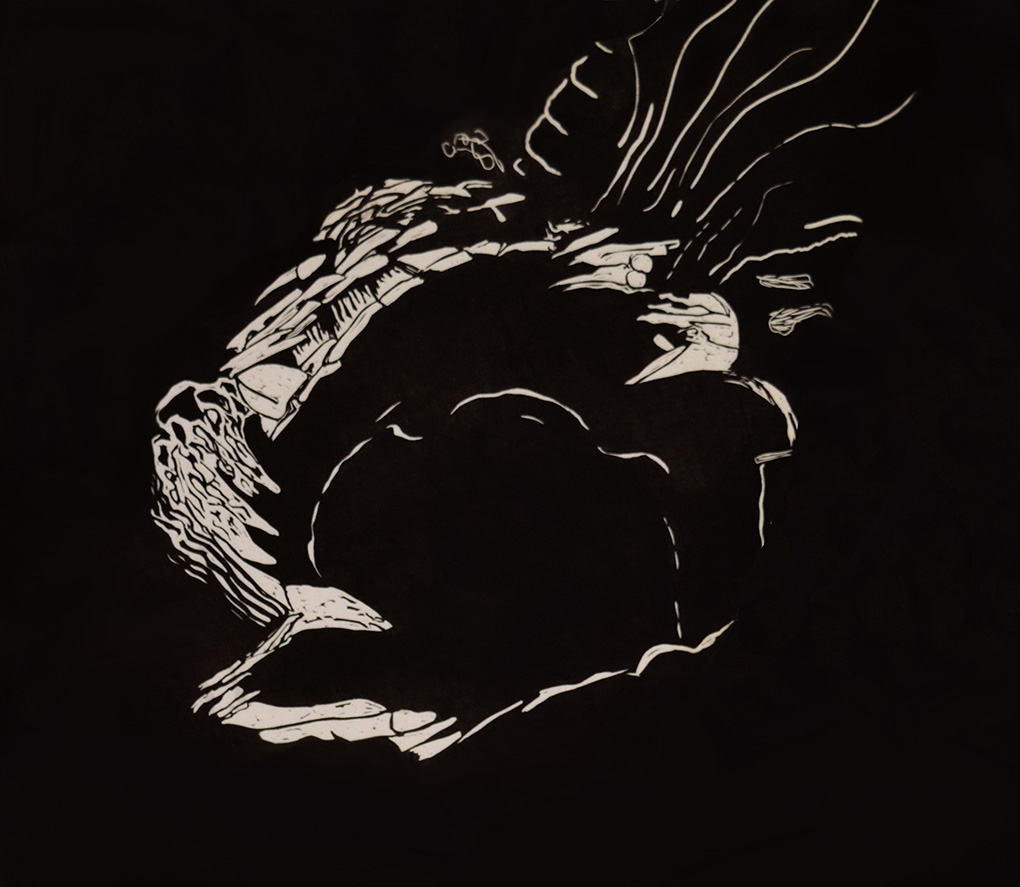PRESS RELEASE
HANNAH HARKES and MARI PREKUP will open their co-exhibition
’The Ground Beneath The Tree Moved Like A Congregation’ in Draakon gallery on the 24th of November at 6pm.

Hannah Harkes and Mari Prekup have shared a working space at Grafodroom printmaking studios in Tallinn since 2013 and have worked closely together on many projects, including the performative collaboration Graforotika (2014-2015) and now, through their new collaborative artistic platform Grafolkoor, they are focusing on folkloric culture, in particular hiipuud (holy trees). Since the spring of 2016 the artists have been making trips to sites across Estonia to visit ancient trees, collecting intriguing stories and legends, and then interpreting these narratives and experiences through the forms of printmaking and sculptural space. The exhibition ’The Ground Beneath The Tree Moved Like A Congregation’ in Draakoni gallery presents the first fruits of this artistic research work. In conjunction with the exhibition the artists are creating an event programme which includes various talks, workshops, and happenings.
Old trees are beings with long, exciting stories, the understanding of which can be rewarding to people from all walks of life, from academics to storytellers, hikers to artists, nature worshippers to forestry businesspeople. Holy trees are strange and exciting places and as we continue to explore them, more and more fascinating aspects begin to peel out. Thematically, the Grafolkloor project addresses universal topics such as folklore, death, and the unknown. The creative process is grounded in psychogeography (defined in 1955 by Guy Debord as ‘the study of the precise laws and specific effects of the geographical environment, consciously organized or not, on the emotions and behavior of individuals’*).
In old times, many important rites and religious practices in Estonia were centred on natural sacred places – whether a holy tree, stone, spring, or all three together. When honouring ancestors, a place of particular importance was their final resting place which was felt as sacred. Although these old burial grounds have largely disappeared over time, there has been instances found of this happening in the 17th and 18th centuries. In addition to burial sites, we find records of sacred groves being connected to mythological beings such as giants, fairies, ghost-dogs, tree-spirits and of course many personal tales and mythologies.
The installative exhibition is the result of a collaboration with architect Kaarel Künnap, thanks to whom we can see the connection between architecture and nature, where each orgamism is supported by nutrients and food from surrounding organisms, forming a fine infrastructure of multiple connections. Through the architectural mapping of folklore we can find that the relationships between places as well as narratives are connected to and supported by an interdependant structure; the installation refers to individual mythologies in fragmented forms, which reflect their cultural context and essence – one fragment from a large mosaic.
We let ourselves be affected by geographical beliefs and heritage. The collected parts – visual materials, narratives, mythologies, histories and sensations – are collated into a single whole.
Exhibition continues until the 30th of December.
Thank you: Graafikakoda and Uku Kann, Labora, Kaarel Künnap, Mihkel Lember, Tõnu Narro, Ahto Kaasik, Kristiina Paabus, Villem Jahu, Tuutu, Karin Link, Lauri Luud, Mall Paris, Johan Pajupuu, Aet, Margit and Aino Admann, Bill Harkes, Õie-Mari Aasmäe, Anu Sillaots, Mikk Sarv, Triin Pruul, Jarõna Ilo, Lianne Teder, Lauri Tankler, Eve Tisler, Lauri Tankler, Fiona Barnes, Olga Titova, Igor Prekup, Anto Liivat, Katrin Reimann, Lianne Teder and many others.
Exhibition is supported by the Cultural Endowment of Estonia and Estonian Artists’ Association.
Exhibitions in Draakon gallery are supported by the Cultural Endowment of Estonia and Estonian Ministry of Culture.
https://grafolkloor.wordpress.com/2017/11/16/events/
_______________________________________________________________________
* ...the study of the precise laws and specific effects of the geographical environment, consciously organized or not, on the emotions and behavior of individuals. Guy Debord, Introduction to a Critique of Urban Geography, in Les Lvres Nues # 6, September 1955
Hannah Harkes is an interdisciplinary artist, working mostly with printmaking, installation and event. Her artistic practice is influenced by situations in which sincerity meets absurdity. Harkes graduated with a BA Hons in Fine Art Printmaking from Gray’s School of Art, in Scotland, in 2011, and has been based in Tallinn, Estonia since. As well as exhibiting internationally, she has worked in various roles within the cultural sector, including co-running Ptarmigan project space; teaching drawing and printmaking at the Estonian Academy of the Arts; and working as the letterpress master at Labora. Hannah Harkes is currently studying on the MA course ‘Death, Religion and Culture’ at the University of Winchester and her coursework naturally runs into this project.
https://hannahharkes.com/
Mari Prekup graduated with an MA from the Estonian Academy of Arts, in the field of Fine Arts, in 2015. She finds her inspiration from heritage, her own experiences, from what’s irritating and from what surrounds her. She deals with old traditions of printmaking at Grafodroom studio, trying to find loopholes for connecting these to new media. Prekup is particularly interested in group dynamics, created by joint projects, installations, organisation of exhibitions and performing arts.
Kaarel Künnap is a city planner, an architect and a poet, who studied at the Estonian Academy of Arts. Currently practicing at Mudel Architects, his work is often focused on the interrelations between society, human psyche, environment and space.
http://mudelarhitektid.ee/